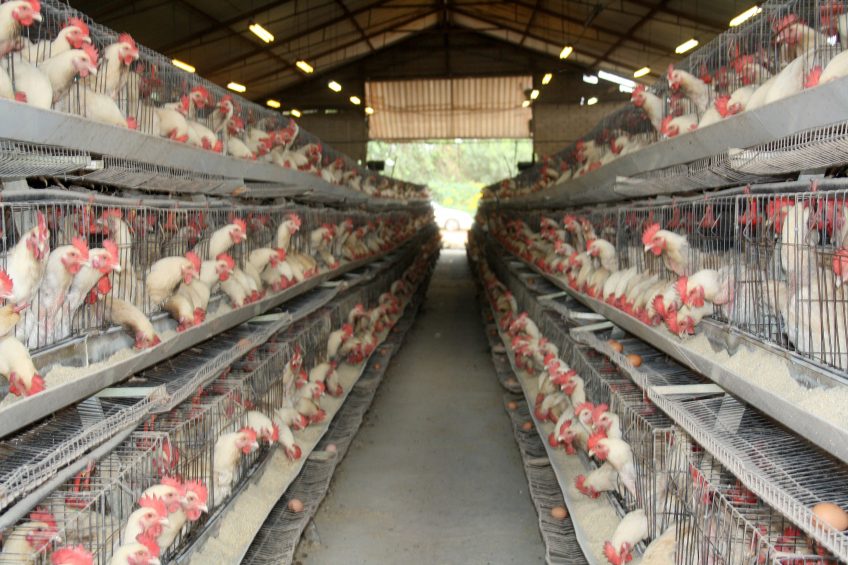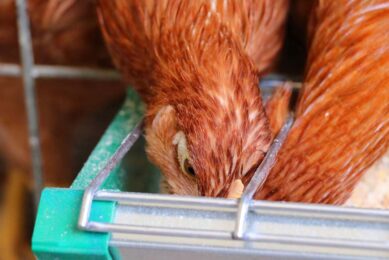Chickens can provide a nice boost to income

The main source of income of the South African Bosparadys farm of the Khourie family comes from dairy production. However, with demand for poultry protein exceeding national production, the 20,000 layers provide a welcome income boost.
With household finances on the increase in South Africa more people can afford to eat meat with poultrymeat top of the shopping list. In fact, poultrymeat accounts for 60% of the total 2.9 million tonnes of beef, poultry and pork meat consumed in the country each year. Broiler meat accounts for most of the poultry meat consumed in South Africa which has risen from 21.5 kg per person per year in 2000 to 38.5 kg per person per year in 2014.
The future for the poultry industry in South Africa is very positive with poultrymeat consumption set to increase by 38% by 2024, according to the Bureau for Food and Agricultural Policy (BFAP). This equates to about 700,000 tonnes of additional poultry consumption, surpassing 44 kg per capita. However, as South Africa only produces 2.4 million tonnes of poultry, beef and pork each year, it will rely heavily on imports to make up the shortfall. The favoured trading partners for meat purchase include Brazil, the Netherlands, the United Kingdom and Germany.
South African poultry farmers have accused a number of EU countries of dumping cheap poultrymeat exports on its door causing prices in the African country to collapse. South Africa imported 392,820 tonnes of poultrymeat at a value of US$ 375 million in 2014, which represents about 2% of world trade in poultrymeat and 4% in quantity.
Dairying dominant
For the South African farmer, keeping chickens can provide a nice boost to incomes particularly on mixed farms because as one sector dips the others can support it. One such mixed farm is operated by the Khourie family located at Magaliesburg, just outside Pretoria. Bosparadys Farm was started by William Khourie and is now run by his sons Joe, Anthony and Pieter, who all take charge of the various different enterprises.
Dairying is the dominant enterprise accounting for 80% of the total farm income but the Khourie’s also farm with sheep, pigs, goats, game and hens. The family have farmed there for over 20 years and have built up a profitable business with an annual turnover of just under R200m (£11.9m).

A total of 2,000 hectares are owned and farmed at Bosparadys and a further 500 hectares are rented from a local landowner.
Around 400 hectares of their land is planted out in grasses and 1,100 hectares is used to produce maize silage averaging 14 tonnes per hectare. The remainder is natural land used for game farming. Anthony Khourie is in charge of feed planning and production, and runs a stable feed bank that provides the fodder flow for continuous dairy production. Joe manages the dairy herd and the heifer herd while Pieter is the overall marketing manager for the farm.
Bosparadys Farm milks 800 cows with an average yield of 30 litres per cow per day but they have a high yielding batch of 250 cows producing 40 litres per day. The high yielders are milked three times per day in the 14/28 herringbone milking parlour while the rest are milked twice per day. The family process their own milk manufacturing yoghurts, cheese and flavoured milk drinks delivered to around 200 retail outlets within a 150 mile radius of the farm on a daily basis.

Eggs follow dairy products
One of the other main enterprises on the farm is a flock of 20,000 laying hens which are used to produce eggs that are sold in the same retail outlets as the dairy products. Anthony and his family use the Hyline Red and White breeds as they receive a higher income from those breeds when they are being sold after their laying term finishes, usually after one year. Anthony says: “Customers prefer the Hyline breed as it provides a tastier meat when slaughtered. We have tried different breeds over the years but these ones work well for us hence why we stick with them.”
The birds are purchased in at 20 weeks of age as laying pullets and reach their laying peak at 30 weeks with a 95% laying rate. The Khouries have found that the most profitable period to keep the birds is within the first year, while maintaining an average 85% laying rate.
Eggs are collected twice per day from the cages and are marketed according to their size with the large ones measuring 30 to 40mm, commanding an income of R15 (£0.89) for one dozen. The retail outlets will add on its margin and sell the eggs for R24 (£1.43). Anthony adds: “The hens provide work for some of our farm workers’ wives who lift the eggs twice per day and grade them.
“It is an important part of our business and generates a good income for the family. We also find the manure very useful in the paddocks for growing grass.

“Eggs are a good source of protein and are quite affordable. We deliver the eggs on a daily basis along with our dairy produce to the same retailers, making it more efficient for our delivery trucks.
“Our hens last about one year which is the optimum period for the maximum laying percentage average. “We do not have any problems with bird flu but we do vaccinate our hens against the normal diseases and take the usual bisosecurity measures to protect the flock,” he adds.
When the hens arrive on the farm they are fed phase one starter feed with 16% protein content. Later in phase two they are fed a lower percentage protein feed which is cheaper to buy. All the feed is purchased but if the farm has any surplus maize from the dairy enterprise they mix it with a high protein content supplement and feed it to the birds. The manure produced by the birds is used to fertilise the grassland pastures with additional assistance from some 28% Nitrogen bag fertiliser that is bought in.
Join 31,000+ subscribers
Subscribe to our newsletter to stay updated about all the need-to-know content in the poultry sector, three times a week. Beheer
Beheer








 WP Admin
WP Admin  Bewerk bericht
Bewerk bericht